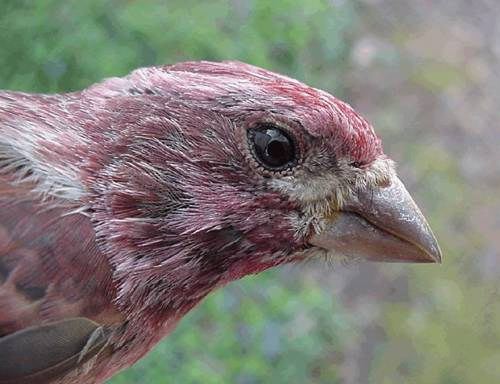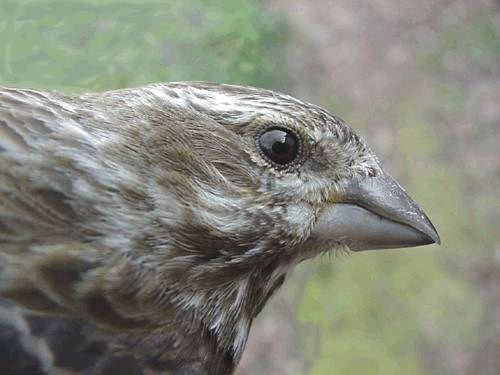 HOME: www.hiltonpond.org |
|
||
|
|
|||
|
|
|||
|
|
|||
|
|
|||
|
|
|||
|
THIS WEEK at HILTON POND |
|
At Hilton Pond Center, we maintain a couple of sunflower seed feeders year 'round, but put out a few extras in early November in anticipation of a big winter finch invasion. Although we have a few resident American Goldfinches and House Finches, their numbers increase around the first of November and peak as the coldest weather arrives in January. The winter of 2000-2001 was a bust, however, and we've seen precious few of either species.  One of the nice things about banding birds at Hilton Pond Center is it allows us to determine more accurately how many birds are actually present--as opposed to making anecdotal observations like "there don't seem to be as many finches this winter." On average over the past 19 years, we've banded 209 American Goldfinches in the first six months of the calendar year, the vast majority of those in January and February. In 2001 we're 50% behind that average, with only 108 new goldfinches captured. House Finches are even further down with an average of 296 expected, compared to only 20 to date in 2001. The biggest bust this winter was Purple Finches; we expect about 135 of these, but hadn't had any this winter until two finally showed up on 22 March--a raspberry-colored male banded here in January 1997 (top photo), and an unbanded brown bird of unknown age and sex (photo below).  From the mid-1980s through the mid-1990s, Purple Finches and House Finches were the mainstays of winter banding at Hilton Pond Center. As many as 700 of each species were banded each year--but their numbers have declined drastically. Pine Siskins--once our fourth most commonly banded species--have slipped to seventh, and the two we banded in the winter of 1999-2000 were the first we had even seen on-site since 1996. In summary, Purple Finches, House Finches, American Goldfinches, and Pine Siskins are all 'way down in numbers, so whither went our winter finches?
As the popularity of birdwatching increases, more and more folks are hanging more and more feeders, and if you're a Purple Finch that's fully capable of surviving the cold, there's not much incentive to migrate from Massachusetts when folks up there are rolling out wheelbarrows full of sunflower seeds every week. We don't begrudge our fellow bird fanciers from the North their right to maintain feeders, we just wish they'd crank it down a notch and encourage a few more "snowbirds" to travel toward the Carolina Piedmont. On cold, damp days in March, we miss those winter birds at Hilton Pond Center, and we PROMISE we'll send them back by May if our northern neighbors once again will share their finches with us.
(For a detailed summary of winter finches at Hilton Pond Center, see Carpodacus finches in South Carolina's Piedmont: Migration, site fidelity, sex ratios, and longevity. If you enjoy "This Week at Hilton Pond," please help Support Hilton Pond Center for Piedmont Natural History |
 There's lots of speculation about the decline of birds at some winter feeding stations, but not a lot of concrete evidence. All the winter finches can be "irruptive species" that occur in big numbers some years and almost not at all in others. This is apparently a weather- and resource-based phenomenon, with northern finches moving further south when populations are large, food is scarce, and/or snow cover is heavy. Disease also plays a role. Pine Siskins seem especially susceptible to outbreaks of salmonella, and eastern populations of House Finches (above left) have been hit hard by highly contagious conjunctivitis (an eye disease).
There's lots of speculation about the decline of birds at some winter feeding stations, but not a lot of concrete evidence. All the winter finches can be "irruptive species" that occur in big numbers some years and almost not at all in others. This is apparently a weather- and resource-based phenomenon, with northern finches moving further south when populations are large, food is scarce, and/or snow cover is heavy. Disease also plays a role. Pine Siskins seem especially susceptible to outbreaks of salmonella, and eastern populations of House Finches (above left) have been hit hard by highly contagious conjunctivitis (an eye disease). American Goldfinches (right) and Purple Finches also occasionally succumb to disease--and undoubtedly more are dying due to house cats, habitat destruction, and other human intervention--but at Hilton Pond Center we support a different hypothesis about why finch numbers have declined locally: Our northern neighbors are buying too much birdseed!
American Goldfinches (right) and Purple Finches also occasionally succumb to disease--and undoubtedly more are dying due to house cats, habitat destruction, and other human intervention--but at Hilton Pond Center we support a different hypothesis about why finch numbers have declined locally: Our northern neighbors are buying too much birdseed!
